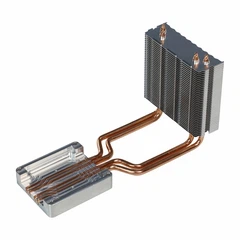The heat dissipation function is very important for new energy vehicles because of their high heating power, which requires the use of high-quality high-power radiators.
Traditional air-cooled radiators generally cannot meet their heat dissipation needs, especially for the heat dissipation of new energy vehicle power battery packs, which have sealing characteristics. The design specifications require electric vehicles to operate efficiently and stably under various weather conditions throughout the year, and the car battery pack directly affects the acceleration and range of the car. Therefore, its stability is a key technology in the entire vehicle, and the key technology to ensure the stable performance of the battery pack lies in its heat dissipation. The battery cooling of power vehicles generally adopts a water-cooled cooling system, with excellent water-cooled plate radiators and related pipeline connection technology to ensure that it operates at a suitable temperature.
Battery Pack
An excellent temperature management system for a power battery pack needs to ensure that the temperature of each individual battery is constant throughout the year, even in extreme hot weather when the battery is used in large quantities. It can ensure timely heat dissipation, prevent battery life from weakening or expanding and exploding, and ensure that the internal temperature of the battery is warm enough in extreme cold weather without affecting performance and lifespan. The heat dissipation of the battery is achieved by flowing a liquid coolant through the water-cooled plate at the bottom of the battery pack, and then directly contacting the individual cells through the cooling plate with excellent thermal conductivity, thereby rapidly cooling the battery.
Water cooled plate radiator
According to technicians from various water-cooled plate manufacturers, the heating and insulation of new energy vehicle power batteries are completed by heaters. The power of the heaters comes from the batteries themselves, which can slightly shorten the range of electric vehicles in cold weather. The cooling system and heating system form the overall thermal management system of electric vehicles.
Charging in extreme environments is a technical challenge for the development of new energy vehicles, as new energy vehicles are in a shutdown state during charging. However, the temperature management system needs to automatically start when it is informed of charging and activate the heating system to maintain the internal temperature of the battery pack. In other words, when the entire vehicle is in a sleep state, the battery pack is still awake and on standby at any time.
In the early stage of charging, it is crucial for the heating system to automatically start heating to ensure the temperature of the battery. This requires high sealing performance for the power battery pack shell, and good sealing performance ensures temperature storage.


